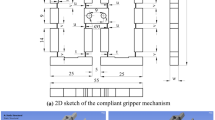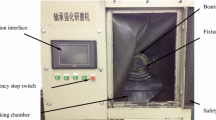Abstract
Design and analysis for flexure-based mechanisms are a challenging task thanks to their movements relied on elastic linkages. Hence, this paper presents a new optimization framework to provide a systematic design method for a flexure gripper. The optimization strategy includes the topology, modeling, and size optimization phases. In the first phase, the topology scheme for the gripper is proposed via the solids isotropic material with penalization method in terms of a full consideration of stress constraint and equal forces of both hands. In the next phase, modeling of the performances is implemented via an enhanced adaptive neuro-fuzzy inference system (EANFIS). The EANFIS’s architectures are optimized by the Taguchi. The EANFIS’s optimization is aimed to search the best parameters and improve the modeling accuracy. It showed that the EANFIS models have a good precision with root mean square error and standard deviation being close to zero, and coefficient of determination around one. In the last phase, the size optimization is performed by the evaporate rate-based water cycle algorithm. Two cases of the flexure gripper are considered in this phase. The results of case 1 found the hand’s stroke of 0.0078 mm, the strain energy of 0.0354 mJ, the stress of 65.332 MPa, and the safety factor of 3.169. The results of case 2 identified the hand’s stroke of 0.0075 mm, the stress of 66.208 MPa, and the safety factor of 3.795. Additionally, the optimized values are close to the finite element verifications. In comparison with the other methods, the results showed that the proposed framework is a best optimizer for the flexure gripper.









Similar content being viewed by others
References
Ling M, Cao J, Jiang Z et al (2019) Optimal design of a piezo-actuated 2-DOF millimeter-range monolithic flexure mechanism with a pseudo-static model. Mech Syst Signal Process 115:120–131. https://doi.org/10.1016/j.ymssp.2018.05.064
Zhang X, Xu Q (2019) Design and testing of a novel 2-DOF compound constant-force parallel gripper. Precis Eng. https://doi.org/10.1016/j.precisioneng.2018.09.004
Ding B, Yang ZX, Zhang G, Xiao X (2017) Optimum design and analysis of flexure-based mechanism for non-circular diamond turning operation. Adv Mech Eng 9:1–10. https://doi.org/10.1177/1687814017743353
Van Tran H, Ngo TH, Tran NDK et al (2018) A threshold accelerometer based on a tristable mechanism. Mechatronics. https://doi.org/10.1016/j.mechatronics.2018.05.013
George BL, Bharanidaran R (2020) Design of multifunctional compliant forceps for medical application. Aust J Mech Eng. https://doi.org/10.1080/14484846.2020.1747151
Chen W, Zhang X, Li H et al (2017) Nonlinear analysis and optimal design of a novel piezoelectric-driven compliant microgripper. Mech Mach Theory 118:32–52. https://doi.org/10.1016/j.mechmachtheory.2017.07.011
Ho NL, Dao TP, Le Chau N, Huang SC (2019) Multi-objective optimization design of a compliant microgripper based on hybrid teaching learning-based optimization algorithm. Microsyst Technol. https://doi.org/10.1007/s00542-018-4222-6
Das TK, Shirinzadeh B, Ghafarian M, Al-Jodah A (2020) Design, analysis, and experimental investigation of a single-stage and low parasitic motion piezoelectric actuated microgripper. Smart Mater Struct. https://doi.org/10.1088/1361-665X/ab79b6
Dao T-P, Huang S-C, Le Chau N (2017) Robust parameter design for a compliant microgripper based on hybrid Taguchi-differential evolution algorithm. Microsyst Technol. https://doi.org/10.1007/s00542-017-3534-2
Nguyen DN, Ho NL, Dao T-P, Le Chau N (2019) Multi-objective optimization design for a sand crab-inspired compliant microgripper. Microsyst Technol. https://doi.org/10.1007/s00542-019-04331-4
Liang J, Zhang X, Zhu B (2019) Nonlinear topology optimization of parallel-grasping microgripper. Precis Eng. https://doi.org/10.1016/j.precisioneng.2019.08.004
Bharanidaran R, Ramesh T (2017) A modified post-processing technique to design a compliant based microgripper with a plunger using topological optimization. Int J Adv Manuf Technol. https://doi.org/10.1007/s00170-015-7801-z
Chen X, Deng Z, Hu S et al (2020) Research on three-stage amplified compliant mechanism-based piezo-driven microgripper. Adv Mech Eng. https://doi.org/10.1177/1687814020911470
Zhang D, Zhang Z, Gao Q et al (2015) Development of a monolithic compliant SPCA-driven micro-gripper. Mechatronics. https://doi.org/10.1016/j.mechatronics.2014.11.006
Yu YQ, Howell LL, Lusk C et al (2005) Dynamic modeling of compliant mechanisms based on the pseudo-rigid-body model. J Mech Des Trans ASME doi 10(1115/1):1900750
Chen G, Ma F, Hao G, Zhu W (2019) Modeling large deflections of initially curved beams in compliant mechanisms using chained beam constraint model. J Mech Robot. https://doi.org/10.1115/14041585
Ling M, Cao J, Pehrson N (2019) Kinetostatic and dynamic analyses of planar compliant mechanisms via a two-port dynamic stiffness model. Precis Eng 57:149–161. https://doi.org/10.1016/j.precisioneng.2019.04.004
Le ZhuW, Zhu Z, Guo P, Ju BF (2018) A novel hybrid actuation mechanism based XY nanopositioning stage with totally decoupled kinematics. Mech Syst Signal Process 99:747–759. https://doi.org/10.1016/j.ymssp.2017.07.010
Gorji MR, Debbaut C, Ghorbaniasl G et al (2021) Electrostatic precipitation pressurized intraperitoneal aerosol chemotherapy (ePIPAC): finding the optimal electrical potential. Eur J Surg Oncol 47:e30. https://doi.org/10.1016/j.ejso.2020.11.222
Farmani S, Ghaeini-Hessaroeyeh M, Javaran SH (2018) The improvement of numerical modeling in the solution of incompressible viscous flow problems using finite element method based on spherical Hankel shape functions. Int J Numer Methods Fluids 87:70–89. https://doi.org/10.1002/fld.4482
Pannu HS, Singh D, Malhi AK (2019) Multi-objective particle swarm optimization-based adaptive neuro-fuzzy inference system for benzene monitoring. Neural Comput Appl. https://doi.org/10.1007/s00521-017-3181-7
Wang D, He T, Li Z et al (2018) Image feature-based affective retrieval employing improved parameter and structure identification of adaptive neuro-fuzzy inference system. Neural Comput Appl. https://doi.org/10.1007/s00521-016-2512-4
Chau N Le, Le HG, Dao T, et al (2019) Efficient hybrid method of FEA-based RSM and PSO algorithm for multi-objective optimization design for a compliant rotary joint for upper limb assistive device. 2019:https://www.springer.com/engineering/electronics/j
Li Z, Shi K, Dey N et al (2017) Rule-based back propagation neural networks for various precision rough set presented KANSEI knowledge prediction: a case study on shoe product form features extraction. Neural Comput Appl. https://doi.org/10.1007/s00521-016-2707-8
Le Chau N, Tran NT, Dao TP (2020) A multi-response optimal design of bistable compliant mechanism using efficient approach of desirability, fuzzy logic, ANFIS and LAPO algorithm. Appl Soft Comput J. https://doi.org/10.1016/j.asoc.2020.106486
Karakatič S (2021) Optimizing nonlinear charging times of electric vehicle routing with genetic algorithm. Expert Syst Appl. https://doi.org/10.1016/j.eswa.2020.114039
Bonyadi MR, Michalewicz Z (2017) Particle swarm optimization for single objective continuous space problems: a review. Evol Comput. 25(1):1–54
Binh HTT, Hanh NT, Van Quan L, Dey N (2018) Improved Cuckoo Search and chaotic flower pollination optimization algorithm for maximizing area coverage in wireless sensor networks. Neural Comput Appl. https://doi.org/10.1007/s00521-016-2823-5
Li S, Gu Q, Gong W, Ning B (2020) An enhanced adaptive differential evolution algorithm for parameter extraction of photovoltaic models. Energy Convers Manag. https://doi.org/10.1016/j.enconman.2019.112443
Sadollah A, Eskandar H, Bahreininejad A, Kim JH (2015) Water cycle algorithm with evaporation rate for solving constrained and unconstrained optimization problems. Appl Soft Comput J. https://doi.org/10.1016/j.asoc.2015.01.050
Eskandar H, Sadollah A, Bahreininejad A, Hamdi M (2012) Water cycle algorithm—a novel metaheuristic optimization method for solving constrained engineering optimization problems. Comput Struct. https://doi.org/10.1016/j.compstruc.2012.07.010
Feng LQ, Iqbal MF, Yang J et al (2021) Prediction of chloride diffusivity in concrete using artificial neural network: modelling and performance evaluation. Constr Build Mater. https://doi.org/10.1016/j.conbuildmat.2020.121082
Talaat M, Gobran MH, Wasfi M (2018) A hybrid model of an artificial neural network with thermodynamic model for system diagnosis of electrical power plant gas turbine. Eng Appl Artif Intell. https://doi.org/10.1016/j.engappai.2017.10.014
Wong EWC, Kim DK (2018) A simplified method to predict fatigue damage of TTR subjected to short-term VIV using artificial neural network. Adv Eng Softw 126:100–109. https://doi.org/10.1016/j.advengsoft.2018.09.011
Eswari JS, Majdoubi J, Naik S et al (2020) Prediction of stenosis behaviour in artery by neural network and multiple linear regressions. Biomech Model Mechanobiol 19:1697–1711. https://doi.org/10.1007/s10237-020-01300-z
Sethukkarasi R, Ganapathy S, Yogesh P, Kannan A (2014) An intelligent neuro fuzzy temporal knowledge representation model for mining temporal patterns. J Intell Fuzzy Syst 26:1167–1178. https://doi.org/10.3233/IFS-130803
Thangaramya K, Kulothungan K, Logambigai R et al (2019) Energy aware cluster and neuro-fuzzy based routing algorithm for wireless sensor networks in IoT. Comput Netw 151:211–223. https://doi.org/10.1016/j.comnet.2019.01.024
Purwanto Eswaran C, Logeswaran R (2011) Improved adaptive neuro-fuzzy inference system for HIV/AIDS time series prediction. Commun Comput Inf Sci 253:1–13. https://doi.org/10.1007/978-3-642-25462-8_1
Davat B (2014) European. J Electr Eng 12:2014
Hao G, Li H (2015) Conceptual designs of multi-degree of freedom compliant parallel manipulators composed of wire-beam based compliant mechanisms. Proc Inst Mech Eng Part C J Mech Eng Sci. https://doi.org/10.1177/0954406214535925
Hao G, He X, Awtar S (2019) Design and analytical model of a compact flexure mechanism for translational motion. Mech Mach Theory. https://doi.org/10.1016/j.mechmachtheory.2019.103593
Karaboga D, Kaya E (2019) Adaptive network based fuzzy inference system (ANFIS) training approaches: a comprehensive survey. Artif Intell Rev 52:2263–2293
Liu M, Zhan J, Zhu B, Zhang X (2020) Topology optimization of compliant mechanism considering actual output displacement using adaptive output spring stiffness. Mech Mach Theory. https://doi.org/10.1016/j.mechmachtheory.2019.103728
Kazakis G, Kanellopoulos I, Sotiropoulos S, Lagaros ND (2017) Topology optimization aided structural design: Interpretation, computational aspects and 3D printing. Heliyon. https://doi.org/10.1016/j.heliyon.2017.e00431
Liu J, Ma B, Zhao H (2020) Combustion parameters optimization of a diesel/natural gas dual fuel engine using genetic algorithm. Fuel 260:116365. https://doi.org/10.1016/j.fuel.2019.116365
Lin SC, Chang CK, Lin NW (2008) Automatic selection of GCC optimization options using a gene weighted genetic algorithm. In: 13th IEEE Asia-Pacific computer systems architecture conference, 2008. https://doi.org/10.1109/APCSAC.2008.4625477
Deng W, Yao R, Zhao H et al (2019) A novel intelligent diagnosis method using optimal LS-SVM with improved PSO algorithm. Soft Comput 23:2445–2462. https://doi.org/10.1007/s00500-017-2940-9
Chen G, Zhang K, Xue X et al (2020) Surrogate-assisted evolutionary algorithm with dimensionality reduction method for water flooding production optimization. J Pet Sci Eng. https://doi.org/10.1016/j.petrol.2019.106633
Zhang X, Duan H (2015) An improved constrained differential evolution algorithm for unmanned aerial vehicle global route planning. Appl Soft Comput J 26:270–284. https://doi.org/10.1016/j.asoc.2014.09.046
Zhang Y, Jin Z, Chen Y (2020) Hybrid teaching–learning-based optimization and neural network algorithm for engineering design optimization problems. Knowl Based Syst. https://doi.org/10.1016/j.knosys.2019.07.007
Korashy A, Kamel S, Youssef AR, Jurado F (2019) Modified water cycle algorithm for optimal direction overcurrent relays coordination. Appl Soft Comput J 74:10–25. https://doi.org/10.1016/j.asoc.2018.10.020
Acknowledgements
This research is supported by Industrial University of Ho Chi Minh City (IUH) under Grant Number 126/HD-DHCN.
Author information
Authors and Affiliations
Corresponding author
Ethics declarations
Conflict of interest
The authors declare that they have no conflict of interest.
Additional information
Publisher's Note
Springer Nature remains neutral with regard to jurisdictional claims in published maps and institutional affiliations.
Rights and permissions
About this article
Cite this article
Dinh, V.B., Tran, N.T. & Dao, TP. An integration framework of topology method, enhanced adaptive neuro-fuzzy inference system, water cycle algorithm with evaporation rate for design optimization for a flexure gripper. Neural Comput & Applic 34, 349–374 (2022). https://doi.org/10.1007/s00521-021-06374-z
Received:
Accepted:
Published:
Issue Date:
DOI: https://doi.org/10.1007/s00521-021-06374-z




